First in a series of posts about my experiences with “Feedback Before Grades”
Holy Mackerel is all I have to say – Ok, well, no I have plenty more to say – but after about a week and a half of holing myself up with my colleague, Kristen McVaugh, (big shout-out to Ms McVaugh who is not only teaching PBL for the first time but was willing to dive into this amazing journey of alternative assessment with me this year too), I am totally exhausted, almost blind as a bat, partially jaded and crazy – but mostly ready for a drink. This little looped video of Nathaniel Rateliff and the Night Sweats pretty much sums it up…
So here was our well-intentioned plan: we wanted to start the year off with a different type of assessment. I put out my feelers on twitter and asked around if anyone had a rubric for grading assessments where the teacher first gave only feedback and then allowed students to do revisions and then once the revisions were done the students received a grade. Kristen and I knew a few things:
- we wanted to make sure the revisions were done in class
- we wanted to make sure the revisions were the students’ own work (tough one)
- we wanted to give students feedback that they needed to interpret as helpful so that we weren’t giving them the answer – so that it was still assessing their knowledge the second time around
- we wanted to make sure that students were actually learning during the assessment
- we wanted students to view the assessment as a learning experience
- we wanted students to be rewarded for both conceptual knowledge and their skills in the problem solving too
So we created this rubric Initial Draft of Rubric for Grading. It allowed us to look at the initial conceptual understanding the student came to the problem set with and also the initial skill level. Kristen and I spent hours and hours writing feedback on the students’ papers regarding their errors, good work and what revisions needed to be done in a back-handed sort of way.
Here are some examples:
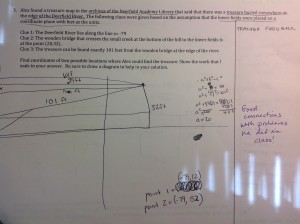
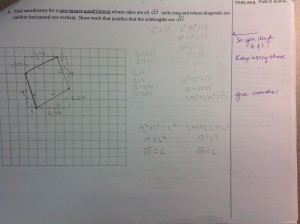
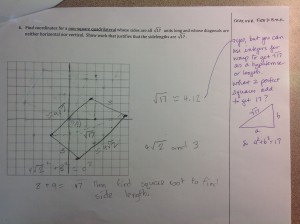
Some kids’ work warranted more writing and some warranted less. Of course if it was wonderful we just wrote something like, excellent work and perhaps wrote and extension question. The hard part was filling out the rubric. So for example, I’ll take Student 3’s work on problem 6 which is the last one above. Here is the rubric filled out for him:
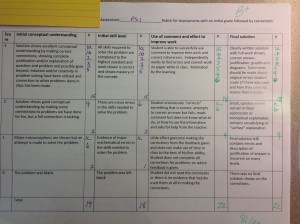
You will notice that I put problem 6 as a 1 for conceptual understanding and a 2 for skill level (in purple). In this problem students were asked to find a non-square quadrilateral with side lengths of sqrt(17). Student 3 was definitely able to find vertices of a quadrilateral, but he was unable to use the PT to find common lengths of sides. I gave him feedback that looking at sqrt(17) as a hypotenuse of a right triangle (as we had done in class) would help a bit and even wrote the PT with 17 as the hypotenuse in the hope of stimulating his memory when he did the revisions.
The day of the revisions Student 3 was only capable of producing this:
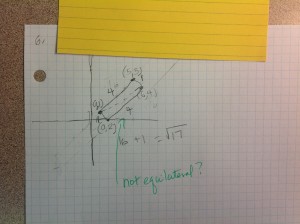
He followed my direction and used 4 and 1 (which are two integers that give a hypotenuse of 17, but did not complete the problem by getting all side lengths the same. In fact, conceptually he kind of missed the boat on the fact that the sqrt(17) was supposed to be the side of the quadrilateral altogether.
One success story was Student 2. She also did this problem incorrectly at first by realizing that you could use 4 and 1 as the sides of a right triangle with sqrt(17) as the hypotenuse but never found the coordinates of the vertices for me. I gave her feedback saying there might be an easier way to do this because she needed vertices. However, she was able to produce this:
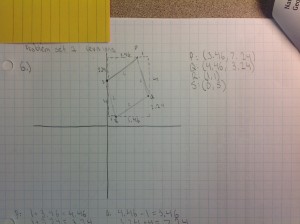
Although she did not give me integer-valued coordinates (which was not required) and she approximated which officially would not really give sqrt(17) lengths it came pretty darn close! I was impressed with the ingenuity and risk-taking that she used and the conceptual knowledge plus the skill-level. Yes, most other kids just used some combination of 1’s and 4’s all the way around but she followed her own thought pattern and did it this way. Kudos to student 2 in my book.
Next time I will talk about some of the lessons we learned, other artifacts from the kids’ work and what we are changing for next time! Oh yeah and some great martini recipes!